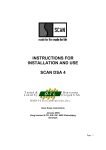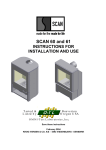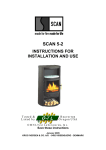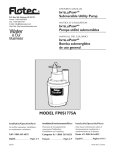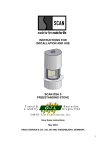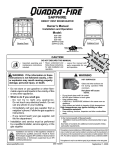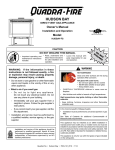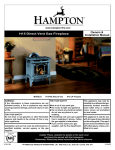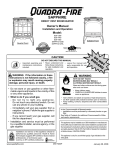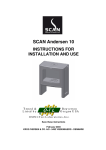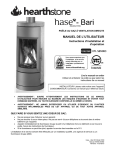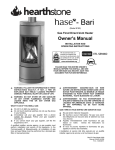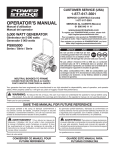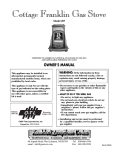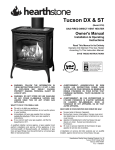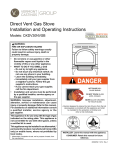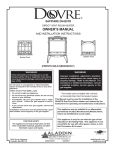Download Installation and User manual
Transcript
Registration no. SCAN 1 & 2 DIRECT VENTED GAS STOVE INSTRUCTIONS FOR INSTALLATION AND USE WARNING: If the information in these instructions is not followed exactly, fire or explosion may result causing property damage, personal injury or loss of life - Do not store or use gasoline or other flammable vapors and liquids in the vicinity of this or any other appliance - WHAT TO DO IF YOU SMELL GAS: • Shut off the gas supply. • Open windows; do not touch any electrical switches. • Do not try to light any appliance, extinguish any open flame. • Do not use the phone in your building. • Immediately call your gas supplier from a neighbor’s phone. Follow the gas supplier's instructions. • If you cannot reach your gas supplier, phone the fire department. - Installation and service must be performed by a qualified installer, service agency or the gas supplier. - The Commonwealth of Massachusetts requires this product be installed by a licensed Plumber or Gas Fitter. SAVE THIS MANUAL FOR FUTURE REFERENCE. This stove may be installed in an aftermarket permanently located manufactured home (USA only) or mobile home where not prohibited by local codes. This stove is only for use with the type of gas indicated on the rating plate. This stove is not convertible for use with other gases unless a certified kit is used. T este d & L i st e d b y B ea v e r to n O r e gon U SA O M N I - T e s t L a b o r a t o r ie s , I n c. September 2005 KROG IVERSEN & CO. A/S 5492 VISSENBJERG DENMARK 1. Introduction: We welcome you as a new owner of a Scan gas stove. In purchasing a Scan gas stove you have joined the growing ranks of concerned individuals whose selection of energy systems reflects both a concern for the environment and aesthetics. The Scan gas stove is one of the finest home stoves the world over. This manual will explain the installation, operation and maintenance of the Scan gas stove. Please familiarize yourself with the owner’s manual before operating your gas stove and save the manual for future reference. Included are helpful hints and suggestions that will make the operation and maintenance of your new stove an easier and more enjoyable experience. We offer our continued support and guidance to help you achieve the maximum benefit and enjoyment from your Scan gas stove. Important information: No other Scan stove has the same registration number as yours. The registration number is fixed to the stove and is located behind the front panel on the right side of the stove. See fig 1. Mail your warranty card today, and save your sales receipt. To receive full warranty coverage, you will need to show evidence of the date you purchased your stove. Do not mail your sales receipt to us. We suggest that you attach your Sales receipt to this page so that you will have all the information you need in one place should the need for service or information occur. We recommend that you fill in the information below. Model: Scan 1 or 2 GAS Registration no. Purchase date: Purchased from: Service Phone no: Gas supplier phone no: 2 2. Safety precautions: ATTENTION CONSUMER: In order to ensure safe and effective installation, this stove must be installed only by a qualified agency, individual, firm, corporation, or company that is experienced in the installation, repair and servicing of this type of stove and is familiar with the building codes and installation techniques appropriate in your area. Contact your stove dealer or local gas supplier for the name of a qualified service person. INSTALLER: Please read this manual carefully before your begin the installation procedures. Failure to follow instructions may result in property damage, bodily injury or loss of life. This manual contains important user information. Keep this manual with the stove after installation is complete. Contact your local building officials to obtain a permit and information on any installation restrictions or inspection requirements in your area. Notify your insurance company of this stove as well It is imperative that control compartments, screens, or circulating air passageways of the gas stove be kept clean and free of obstructions. These areas provide the air necessary for safe operation. Do not store or use gasoline or other flammable liquids in the vicinity of this stove. If the flame becomes sooty dark orange in color or extremely tall, do not operate the stove. Call your dealer and arrange for proper servicing. Do not operate the stove if it is not operating properly in any fashion or if you are uncertain. Call your stove dealer for a full explanation of your stove and what to expect. Do not use this stove if any part has been under water. Immediately call a qualified service technician to inspect the stove and to replace any part of the control system and any gas control; which has been under water. Do not place clothing or other flammable items on or near the stove. Because a thermostat can control this stove there is a possibility of the heater to turning on and igniting any items placed on or near it. The viewing glass should only be open for conducting service or maintenance. Any safety screen or guard removed for servicing must be replaced prior to operating the stove. Do not operate with the glass removed or damaged. Operate the stove according to the instructions included in this manual. If the main burner does not start correctly, turn the gas off at the gas control valve and call your stove dealer for service. This stove is not for use with solid fuel. 3 Do not place anything inside the firebox (except the included gas logs, baffle plate and fire back plates). If the log set became damaged, replace with an original Scan log set. Children and adults should be alerted to the hazards of high surface temperature and should stay away to avoid burns or clothing ignition. Instruct everyone in the house how to shut gas off to the stove and at the gas main shut off valve. The gas main shut off valve is usually next to the gas meter or propane tank and requires a wrench to shut off. Start the stove using the built-in piezo igniter. Do not use matches or any other external device to light your stove. Never remove, replace, modify or substitute any part of the stove unless instructions are given in this manual. All other work must be done by a trained technician. Do not modify or replace orifices The pilot flame must contact the thermopile and thermocouple (see section 6.3) if it does not, turn on the gas control valve to OFF and call your stove dealer. Do not throw this manual away. This manual has important operating and maintenance instructions that you will need at a later time. Always follow the instructions in this manual. If the stove is equipped with optional blower; which requires 120 volt power, do not remove the grounding prong from the plug. Do not route the electrical cord in front of, over, or under the stove. Krog Iversen & CO grants no warranty, implied or stated, for the installation or maintenance of your stove, and assumes no responsibility of any consequential damage(s). Please see section 9 Warranty conditions. The stove, when installed, must be electrically grounded in accordance with local codes or, in the absence of local codes, with the National Electrical code, ANSI/NFPA 70, or the Canadian Electrical Code, CSA C22.1 4 3. Table of Contents: 1. Introduction:................................................................................................................................................................................................2 2. Safety precautions: ......................................................................................................................................................................................3 3. Table of Contents:.......................................................................................................................................................................................4 3. Table of Contents:.......................................................................................................................................................................................5 4. Specifications ..............................................................................................................................................................................................6 4.1 Features:....................................................................................................................................................................................................6 4.2 Installation options:...................................................................................................................................................................................6 4.3 Heating specifications: ..............................................................................................................................................................................6 4.4 Weight:......................................................................................................................................................................................................6 4.5 Dimensions: ..............................................................................................................................................................................................7 4.6 Fuel: ..........................................................................................................................................................................................................7 5. Installation (for qualified installer only):....................................................................................................................................................8 5.1 Installation warnings: ................................................................................................................................................................................8 5.2 Packing list:...............................................................................................................................................................................................8 5.3 Additional items required:.........................................................................................................................................................................8 5.4 Installation overview:................................................................................................................................................................................9 5.5 Installation hints:.......................................................................................................................................................................................9 5.6 High altitude: ............................................................................................................................................................................................9 5.7 Stove clearances:.....................................................................................................................................................................................10 5.8 Mobile home requirements:.....................................................................................................................................................................10 5.9 Stove placement requirements.................................................................................................................................................................10 5.10 Floor protection requirements: ..............................................................................................................................................................11 5.11 Gas line installation:..............................................................................................................................................................................11 5.12 Gas inlet pressure: .................................................................................................................................................................................12 5.13 Vent requirements: ................................................................................................................................................................................13 5.14 Vent restrictor adjustment: ....................................................................................................................................................................14 5.15 Approved venting configurations for vertical terminations with two 90° elbows: ................................................................................15 5.16 Approved venting configurations with a horizontal termination and one 90° elbow:............................................................................16 5.17 Approved venting configurations for vertical terminations:..................................................................................................................17 5.18 Vent termination clearances: .................................................................................................................................................................19 5.19 Finalizing the installation ......................................................................................................................................................................20 5.20 Scan 1 Gas: ..........................................................................................................................................................................................21 5.21 Removal of: face and glass panels: .......................................................................................................................................................22 5.22 Firebrick and baffle plate installation:...................................................................................................................................................23 5.23 Log installation: ....................................................................................................................................................................................24 6. Operation: .................................................................................................................................................................................................25 6.1 Before you begin:....................................................................................................................................................................................25 6.2 For your safety read before lighting: .......................................................................................................................................................26 6.3 Lighting instructions: ..............................................................................................................................................................................27 6.4 Starting the stove for the first time: .........................................................................................................................................................28 6.5 Adjusting the flame height: .....................................................................................................................................................................28 6.6 Adjusting the blower speed (optional): ...................................................................................................................................................29 6.7 Normal operating sounds: .......................................................................................................................................................................29 7. Maintenance: (for qualified service personnel only) ................................................................................................................................29 7. Maintenance: (for qualified service personnel only) ................................................................................................................................30 7.1 Maintaining your stove’s appearance:.....................................................................................................................................................30 7.2 Annual service procedure:.......................................................................................................................................................................30 7.3 Troubleshooting table: ............................................................................................................................................................................31 7.4 How this stove works:.............................................................................................................................................................................32 7.5 Millivolt wiring diagram: ........................................................................................................................................................................33 7.6 Replacement part list:..............................................................................................................................................................................33 8. Optional equipment (for qualified installer only):....................................................................................................................................34 8.1 Conversion from NG to LP (for qualified installer only): ......................................................................................................................34 8.2 Conversion from LP to NG (for qualified installer only): .......................................................................................................................34 8.3 Blower (optional): ..................................................................................................................................................................................37 8.4 Wiring diagram for blower 120 Volt:......................................................................................................................................................38 8.5 Remote control:.......................................................................................................................................................................................39 9. Warranty conditions for SCAN gas burning products:..............................................................................................................................40 10. CROSS REFERENCE CHART..............................................................................................................................................................41 11. Safety label..............................................................................................................................................................................................42 5 4. Specifications 4.1 Features: - Works during power outages (millivolt system) - High efficiency - Optional thermostat or remote control with thermostat. - Realistic wood fire look - Optional blower for quick heat distribution - Convenient operating controls - Variable rate heat output - Low maintenance 4.2 Installation options: - Freestanding stove - Horizontal or vertical vent - Residential or mobile home - Straight or corner placement - Bedroom approved 4.3 Heating specifications: Approximate heating capacity (in square feet) 500 - 1700 with blower, 500 - 1200 without. Maximum input 30000 BTU Output range in BTU per hour 16500 to 26000 Steady state efficiency up to 79% AFUE (without blower) up to 78% *Heating capacity will vary depending on the home’s floor plan, degree of insulation, and the outside temperature. ** Efficiency rating is a product of thermal efficiency rating determined under continuous operation independent of installed system. We recommend that the pilot is turned off during summer. 4.4 Weight: Scan 1 Gas 235 lbs. Scan 2 Gas with steel plate 212 lbs. Scan 2 Gas with soapstone 306 Lbs. 6 4.5 Dimensions: Electrical specification for optional blower: 115 volt 60 Hz (66 watts on high) 4.6 Fuel: This stove is shipped in natural gas (NG) configuration but may be converted to propane (LP) using a LP conversion kit. The sticker on top of the gas control valve will verify the correct fuel. 7 5. Installation (for qualified installer only): THIS STOVE MUST BE INSTALLED AND MAINTAINED BY A QUALIFIED SERVICE AGENCY. The installation and repair of this stove must be done by a qualified service person. Failure to properly install and maintain this stove could result in an unsafe or hazardous installation, which may result in a fire, explosion, property damage, personal injury or loss of life. This stove should be inspected before use and at least annually. More frequent cleaning may be required due to excessive lint from carpeting, bedding material, etc. It is imperative that control compartments, burners and circulating air passageways of the stove be kept clean. 5.1 Installation warnings: Failure to follow all of the requirements may result in property damage, bodily injury, or even death. This stove must be installed by a qualified installer who has gone through a training program for the installation of direct vent gas stoves. This stove must be installed in accordance with all local codes, if any; If not, in USA. Follow ANSI Z223.1 and NFPA 54 (88), in Canada follow CAN/CGA B-149. In manufactured or mobile homes installation must conform with: USA, Manufactured home construction and safety standard, title 24 CFR, part 3280 or when such a standard is not applicable ANSI/NCBCS A 225.1; In Canada, CSA Z 240.4. This stove may be installed in manufactured housing only after the home is site located. This stove is designed to operate on natural gas or propane (LP). All exhaust gases must be vented outside the structure of the living-area. Combustion air is drawn from outside the living-area structure. Notify your insurance company before hooking up this stove. The requirements listed below are divided into sections. All requirements must be met simultaneously. The order of installation is not rigid – the qualified installer should follow the procedure best suited for the installation. 5.2 Packing list: - Box with: Front fire brick plate, back fire brick plate and upper baffle plate - Box with: Log set ( consist of 5 pieces) - Box with: Hexagon keys, wrenches, 3 restrictor plates, 3/8" F.P.T. 3 gas line connecting pipes and 2 elbows and 2 retainers for the upper baffle plate. 5.3 Additional items required: - Vent (see “venting requirement” for details) - Gas line equipment (shutoff valve, pipe, etc.) 8 5.4 Installation overview: 5.5 Installation hints: - If converting to LP, convert the stove prior to installation. - The blower is easiest to install prior to installation of the stove. - We recommend using the included pipe and elbow to route the gas inlet around the blower position. - Install the logs last because they are fragile. - When determining the location of the stove, locate the wall studs (for horizontal penetrations) and ceiling trusses (for vertical penetrations). You may wish to adjust the stove position slightly to ensure the vent does not intersect with a framing member. - Fumes and smoke from the paint curing and oil burning off the steel may occur the firs time you start this stove. This is normal. We recommend you open windows to vent the room. 5.6 High altitude: If the stove is to be installed in more than 2000 feet above sea level it maybe necessary to change the orifice size in accordance with the table below. For change orifice in NG configuration to high altitude take a standard LP orifice and drill it up in accordance with the table below. For change orifice in LP configuration to high altitude it is necessary to have a special orifice part no. 3601067 and drill it up in accordance with the table below. Hint: If you are drilling on the job, drilling an orifice opening at least two sizes smaller than called for is good practice to start with. Gas type Feet Orifice Drill size NG 2000 - 4500 2.60 mm 38 NG 4500 - 5500 2.55 mm 39 NG 5500 - 6500 2.50 mm 40 NG 6500 - 8500 2.45 mm 41 NG 8500 - 10000 2.35 mm 42 LP 2500 – 7500 1.50 mm 53 LP 7500 - 10000 1.40 mm 54 NOTE: In Canada you can install the stove up to 4500’ without changing the orifice 9 5.7 Stove clearances: 5.8 Mobile home requirements: When the stove is installed in a mobile home it must be bolted to the floor. The stove, when installed, must be electrically grounded in accordance with local codes or, in the absence of local codes, with the National Electrical Code, ANSI/NFPA 70, or the Canadian Electrical Code, CSA C22.1. 5.9 Stove placement requirements - Stove must be installed on a level surface capable of supporting the stove and vent. - Due to the high temperature of the stove, it should be located out of traffic and away from furniture and draperies. The stove must be placed so no combustibles are within, or can swing within 36 inches of the front of the stove (e.g. drapers, doors). - When placed in a location where the floor to ceiling high is under 7 feet, the installation is considered an alcove and must meet the following requirements: The alcove floor to ceiling height must be at least 70” The alcove must not be more than 24” deep before the ceiling returns to 7’ The alcove must be at least 29” wide - The stove must not be placed so the vent is below or above the door, along the side of stove, or along the back of the heater can be blocked. - This stove may be placed in a bedroom, but please be aware of the large amount of heat this stove produces when determining a location. NOTE: We do not recommend the use of wallpaper next to this stove. Over time, radiant heat may cause the wallpaper to shrink, or may adversely affect the binders in the wallpaper adhesive. 10 5.10 Floor protection requirements: When the stove is installed directly on carpeting, vinyl or other combustible material other than wood flooring or a high pressure laminate wood floor, the stove must be installed on a metal or wood protection panel extending the full width and depth of the stove (minimum 20½“ wide by 16 “ deep) 5.11 Gas line installation: - The gas line must be installed in accordance with all local codes, if any: If not; follow current ANSI Z223.1 or NFPA 54 in USA and current CGA B 149 in Canada. - The stove and gas control valve must be disconnected from the gas supply piping during any pressure testing of that system at test pressures exceed ½ psig (3.45 kPa). For pressures equal to or less than ½ psig (3.45 kPa), isolate the gas supply piping by closing the manual shutoff valve. - This stove is designed for natural gas but can be converted to propane. Check the sticker on top of the gas control valve to verify the correct fuel is being used (see section 8.1). - Leak test all gas line joints and the gas control valve prior to and after starting the stove. - The gas inlet accepts a 3/8” F.P.T. fitting. - The location of the gas inlet is shown below. - A manual shutoff valve is required for installation (it must be located within 3’ of the stove) 11 5.12 Gas inlet pressure: - With the stove off the inlet pressure must meet the requirements listed in the table below - If the pressure is not sufficient, make sure the piping used is large enough and the total gas load for residence does not exceed the amount supplied. - The supply regulator (the regulator that attaches directly to residence inlet or to the propane tank) should supply gas at the suggested input pressure listed below. Contact the local gas supplier if the regulator is at improper pressure. Standard input pressure Natural gas 7” W.C. (1.74 kPa) Propane 11”W.C. (2.73 kPa) 12 5.13 Vent requirements: Always maintain the required 1” clearance (air space) to combustible materials to prevent a fire hazard. Do not fill air spaces with insulation. The gas stove and vent system must be vented directly to the outside of the building and never be attached to a chimney serving a separate solid fuel or gas-burning appliance. Each direct vent gas appliance must use it’s own vent system. This stove is equipped only for altitudes 0-2000 ft. (0-610 m) in USA; In Canada, 0-4500 ft. (0- 1370 m). When the vent passes through a wall, a wall thimble is required. When the vent passes through a ceiling, a support box or fire stop is required. When the vent passes through the roof, a roof flashing and storm collar are required. Follow the instructions provided with the vent system; for installing of these items. For the direct vent system use: Selkirk Direct Temp TM , For the nearest supplier call 1-800 992 8368. Or. Simpson Dura-vent model GS, for the nearest supplier call 800 835 4429. Follow the installation instructions included with the vent system. Apply high-temperature silicone to the inner and outer pipe before assembling the sections (on the male, upper section). This seals the inner pipe from the outer pipe. Slide the sections together and turn ¼ turn until the sections lock in place. Install three metal screws through each joint to lock the outer section in place (See the instructions included with the vent for further details). NOTE: You may screw the first section of the vent to the stove without silicon. Horizontal sections require a ¼ “ rise every 12” of travel. Exterior vent diameter = 6 5/8”, inner vent diameter = 4”. Horizontal sections require non-combustible support every 36” (e.g.: use plumbing tape). 13 5.14 Vent damper adjustment: There is a damper system built in the stove in order to control the flow rate of exhaust gases. This ensures proper flames for the wide variety of vent configurations. Depending upon the vent configuration, you may be required to adjust the damper within the firebox Consult the vent run specifications in section 5.14, 5.15 and 5.16 to determine the damper settings for the actual vent configuration. Vent damper adjustment in the firebox 14 5.15 Approved venting configurations for vertical terminations with two 90° elbows: The termination must fall within the shaded area shown in the chart. Adjust the vent damper to the indicated setting, vent damper adjustment is located in the firebox. See 5.14 15 5.16 Approved venting configurations with a horizontal termination and one 90° elbow: If using a snorkel termination (14” or 36”) add the snorkel height to the vertical height (snorkel terminations are used primarily for basement installations). The termination must fall within the shaded area shown in the chart. Adjust the vent damper to the indicated setting; vent damper adjustment is located in the firebox. See 5.14 16 5.17 Approved venting configurations for vertical terminations: The termination must fall within the shaded area shown in the chart. Adjust the vent damper setting to the indicated; vent damper adjustment is located in the firebox. See 5.14 17 ALWAYS MAINTAIN REQUIRED CLEARANCES (TO NEARBY COMBUSTIBLES TO PREVENT FIRE HAZARD. DO NOT FILL AIR SPACES WITH INSULATION. ALL VENTING COMPONENTS MUST MAINTAIN 1” (25 MM) CLEARANCE TO COMBUSTIBLE MATERIALS. THE GAS STOVE AND VENT SYSTEM MUST BE VENTED DIRECTLY TO THE OUTSIDE OF THE BUILDING AND NEVER BE ATTACHED TO A CHIMNEY SERVING A SEPARATE SOLID FUEL OR GAS-BURNING APPLIANCE, EACH DIRECT VENT APPLIANCE MUST USE ITS OWN SEPARATE VENT SYSTEM. COMMON VENTS ARE PROHIBITED. REFER TO THE MANUFACTURER’S INSTRUCTIONS INCLUDED WITH THE VENTING SYSTEM FOR COMPLETE INSTALLATION PROCEDURES. The horizontal termination must not be recessed into the exterior wall or siding. Horizontal vent runs must be level or rise ¼” per foot toward the vent termination. Clearances around the vent termination must be maintained. For installations using Simpson DuraVent pipe, parallel installations with minimum wall clearance have restricted access for connecting the Horizontal vent cap straps to the vent pipe. See the manufacturer’s instructions for recommended installation procedures. 18 5.18 Vent termination clearances: The location of the vent terminal must meet clearance specifications as shown in fig 11 – 13. Also follow these guidelines when determining the vent terminal location: 1. Do not locate the terminal where people come into accidental contact with it while the stove is operating. 2. There must not be any obstructions such as bushes, fences, decks, garden sheds, or utility buildings within 24” (60 cm) of the terminal cap. 3. Do not locate the terminal where it might be damaged by such things as car doors, lawn mowers, or snow blowers. The terminal should be located away from areas where it could become blocked by snow or ice build–up. Be sure to check the vent termination area after snow falls and clear it to prevent accidental blockage of the vent system. When using a snow blower, be careful to direct snow away from the terminal area. A: Clearance above grade, veranda, porch, deck, or balcony – * 12” (30 cm) min. B: Clearance to window or door that may be opened - * 12” (30 cm) min. to top and sides * 24” (60 cm) min. below. C: Clearance to permanently closed window – 12” (30 cm) min. recommended to prevent condensation on window above. D: Vertical clearance to ventilated soffit located above the terminal within a horizontal distance of 2 feet (60 cm) from the centerline of the terminal – 18” (46 cm) min. E: Clearance to unventilated soffit 12” (30 cm) min. F: Clearance to outside corner – 6” (15 cm) to combustible, 2” (50 mm) to noncombustible. G: Clearance to inside corner – 6” (15 cm) to combustible, 2” (50 mm) to noncombustible. H: May not be installed above a meter/regulator assembly within 3 feet (90 cm) horizontally from the centerline of the regulator. I: Clearance to service regulator outlet - * 6 feet (1.8 m) min. J: Clearance to non-mechanical air supply inlet for the building or to the combustion air inlet to any other fireplace - * 12” (30 cm) min. 19 K: Clearance to a mechanical air supply inlet - 6’ (1.8 m) min. L: ** Clearance above paved sidewalk or paved driveway located on public property - * 7 feet (2.1 m) min. (for U.S. installations follow the current National Fuel Gas Code ANSI Z223.1) M: Clearance under veranda, porch, deck, or balcony – 18” (46 cm) min. (see Note A) N: Clearances to trees, bushes, - 24” (60 cm). ** A vent shall not terminate directly above a sidewalk or paved driveway, which is located between two singlefamily dwellings and serve both dwellings. * For U.S. installations follow the current National Fuel Gas Code ANSI Z233.1 Note A: Only permitted if veranda, porch, deck, or balcony is fully open on a minimum of 2 sides beneath the floor. Note B: As specified in CGA/CGA B 149 (1 or 2), installation Codes (1991). Note: Local codes or regulations may require different clearances. 5.19 Finalizing the installation 1. 2. 3. 4. 5. 6. Make sure the gas control valve is “OFF” and the stove is cool prior to conducting service. Remove the face glass panels and the firebox glass panel (See section 5.20). Install the log set (See section 5.21). We recommend you purge the gas line at this time (With the glass removed). This allows gas to be detected once it enters the firebox, ensuring gas does not build up. Turn on the gas the stove. Leak test all gas joints prior to starting the stove. Start the pilot. Replace and secure the glass panels: (See section t.20). The main burner. Leak test all joints again. Check the pilot flame to make sure that it reaches both the thermocouple and thermopile. Adjust the pilot flame if necessary. (See section 6.3). 20 If the vent configuration is installed incorrectly the vent may cause the flames inside the firebox to lift or “ghost” – a dangerous situation. Inspect the flames after installation to ensure proper performance. If the vent configuration is correct, yet the flames are lifting or ghosting, shut off gas to the stove and contact the dealer for information on remedying the problem. The flames should burn right off the top of the burner ports. If the flames are lifting, then the vent configuration is probably not correct, contact your stove dealer. If the flames are ghosting, then the vent configuration is probably not correct, contact your stove dealer 7 Turn the flame adjust knob to its highest position – the flames should not be dark in the ends. Check the flame on low position. The flames should burn out of each burner hole. If the stove does not work correctly, contact your stove dealer for service. 8 Give this manual to the homeowner and fully explain the operation of this stove. 5.20 Scan 1 Gas: Transport safety lock nut. You have to turn it all the way up. Use a 10 mm open-end wrench. 21 Remove this panel by lifting it up against the top and move the bottom part out towards the front. 5.21 Removal of: face and glass panels: Make sure the gas control valve is "OFF" and the stove is cool prior to conducting service. For Scan 1 Gas start on previous page. Lift off the top plates. When mounting the plate again observe the notch and guiding pins to fix the plates in place Remove the firebox glass panel by unlocking the locking hatches and draw the top of the panel out and lift up. Use a 10 mm nutdriver or a 10 mm open end wrench. Remove the front panel by lifting it up and then out. 22 5.22 Firebrick and baffle plate installation: Fire brick plate is to be placed in first and is fixed by mounting the upper baffle plate. Bracket for securing the baffle plate. There is one for the left and one for the right side. 23 Upper baffle plate is to be leant on the platform on the back plate and mounted on the pins in the side plate of the firebox. 5.23 Log installation: Make sure the gas control valve is "OFF" and the stove is cool prior to conducting service. Failure to position the parts in accordance with these diagrams or failure to use only parts specifically approved with this stove may result in property damage or personal injury. NOTE: The burner must be correctly positioned Observe the two guidance pins for these logs. The top logs are to be placed in the recesses in the lower logs 24 6. Operation: 6.1 Before you begin: Warning: Read the entire manual before you use your stove (especially the section 2 “Safety Precautions”). Failure to follow the instructions may result in property damage, bodily harm, or even death. Warning: Do not operate the stove with any of the glass panels removed, cracked or broken. A licensed or qualified person should do the glass replacement. Warning: Do not abuse the door such as striking at them. Controls location: An instruction card for operation of the stove is attached to the inside of the stove here. Replace it for easy reference. On/off switch: This control is used to turn the flame on and off. Optional blower control: This knob turns on and controls the speed of the internal convection blower that pushes heated air into the room. Gas control knob: This knob controls gas to the stove pilot. There are three positions, ON, OFF, and pilot. The indicator line is to the left of the knob. Flame adjust knob: This knob controls the flame height from low (“LO”) to high (“HI”). The indicator line is above the knob. Pilot igniter: The pilot igniter is used only to start the pilot. When pressed, it sends an electrical charge to the pilot assembly. This creates a blue spark directly next to the pilot, igniting the pilot flame. Remote control: If using a remote control with thermostat, the on/off switch must be “OFF”. Turning the on/off switch “ON” will keep the stove on always. 25 6.2 For your safety read before lighting: "WARNING: If you do not follow these instructions exactly, a fire or explosion may result causing property damage, personal injury or loss of life." 1. 2. 3. • • • • 4. 5. 6. This stove is equipped with an ignition device, which must be operated by hand when lighting the pilot. Follow these instructions exactly. BEFORE LIGHTING, smell all around the stove area for gas. Be sure to smell next to the floor because some gas is heavier than air and will settle on the floor. WHAT TO DO IF YOU SMELL GAS: Do not try to light any stove. Do not touch any electric switch; do not use any phone in your building. Immediately call your gas supplier from a neighbor’s phone. Follow the gas supplier’s instructions. If you cannot reach your gas supplier, call the fire department. Use only your hand to push in or turn the gas control knob. Never use tools. If the knob will not push in or turn by hand, don’t try to repair it. Call a qualified service technician. Force or attempted repair may result in a fire or explosion. Do not use this stove if any part has been under water. Immediately call a qualified service technician to inspect the stove and to replace any part of the control system and any gas control, which has been under water. Do not block any control compartments, screens or circulating air passageways. These areas provide air necessary for safe operation. 5 minutes Fig. 10 Pilot burner location 26 6.3 Lighting instructions: 1. 2. 3. 4. 5. 6. 7. 8. 9. 10. 11. 12. 13. STOP! Read the safety information in Section 6.2 and below this before proceeding. Set the thermostat to lowest setting (If applicable). For a stove, which utilizes an external electrical supply: Turn off all electric power to the stove. (Room air blower if applicable) Push the gas control knob in slightly and turn it clockwise to the “OFF” position. NOTE: The knob will not turn from “ON” to “OFF” unless the knob is depressed slightly. Do not force. Wait five (5) minutes to clear out any gas. Then smell for gas, including near the floor, if you smell gas, STOP! Follow “B” in the safety information in section 6.2. If you don’t smell gas, go to the next step. Turn gas control knob counterclockwise to the “PILOT” position. Press the knob in and hold. Immediately press the igniter button repeatedly until the pilot is lit. WARNING: If the pilot does not light after 30 seconds, release the knob and call your stove dealer for service. See fig 10 on previous page for pilot burner location. Keep the gas control knob depressed for 30 seconds once the pilot is lit. Release the gas control knob. If the pilot goes out. Repeat step 7, 8 and 9. * If the knob does not pop up when released, stop and immediately call your stove dealer or gas supplier for service. * If the pilot will not stay lit after several tries, turn the gas control knob to “OFF” and call your stove dealer or gas supplier for service. Turn the gas control knob counterclockwise to “NO”. Turn on the electric power to the stove. Blower (room air blower) on the stove. Set the thermostat to desired setting (if applicable) or use the ON/OFF rocker switch or remote control to operate the main burner. Pilot igniter Correct pilot burner pattern 30 seconds 27 6.4 TO TURN OFF GAS TO STOVE: 1. 2. 3. 4. Set the thermostat to lowest setting (if applicable). Turn off the blower (room air blower) on the stove. Turn off the electric power to the stove if service is to be performed. Push the gas control knob in slightly and turn it clockwise to the “OFF” position. 6.4 Starting the stove for the first time: Fumes from the painted surfaces curing: Burn the stove at a medium setting for approximately one hour the first time. This will cure the painted surfaces. Fumes from the paint curing and oil burning off the steel may occur. This is normal. We recommend you open a window to vent the room. Condensation: Water may appear on the glass each time you start the stove – this is normal. Blue flames: The flames will be blue when first started, after fifteen minutes the flames will turn to a more realistic yellow and orange color. Turning the stove on and off after the pilot has been started. See the instructions included with the remote for details on operation Use this switch to turn the main burner on and off manually See the instructions included with the remote for changing the battery Warning: Do not place combustible items on top or directly in front of the stove, even temporarily. The operation thermostat may start the heater causing a combustible item to ignite. Note: If the stove turns on and off frequently while using the thermostat function in the remote control you may want to adjust the flame height down until it produces just enough heat needed 6.5 Adjusting the flame height: Your stove has an adjustable flame to tailor the look and heat output to your specific needs. It is adjusted by turning the middle dial on the gas control valve. Flame height adjustment knob Center mark Turn counter-clockwise to adjust the flame higher, clockwise to lower 28 6.6 Adjusting the blower speed (optional): The blower helps transfer the heat from the stove to the room. It will not turn on until the stove is up to temperature (approximately 15 minutes after starting). See the illustration below for instructions. OFF Turn the dial all the way counterclockwise until it clicks off. Low The high position is all the way counter-clockwise, without clicking off. High Turn the dial all the way clockwise. 6.7 Normal operating sounds: The stove may creak with change of temperature. THIS IS NORMAL. Pilot flame The pilot flame, which remains on, makes a very slight ”whisper” sound. Blower (optional) If the stove uses a blower. You will hear the sound of air movement that increases as the speed is increased. Gas control valve As the gas control valve is turned on and off you will hear a dull clicking sound. This is the valve opening up and shutting down. 29 7. Maintenance: (for qualified service personnel only) 7.1 Maintaining your stove’s appearance: Painted surfaces: Painted surfaces should be cleaned with a duster. If scratches occur, lightly sand the area with fine sandpaper. Clean the area and, with the stove at ambient temperature, apply one or two thin coats of stove paint to the area (Mask the area to avoid over spray). Allow the stove to dry then turn the stove on to cure the paint (1 hour on medium. Glass: Clean the glass with soap and water (do not use abrasive cleaners). To dismount the glass panels please refer to section 5.20. 7.2 Annual service procedure: Caution: Use only SCAN original spare parts for maintenance or repair of the stove. Failure to inspect and maintain the stove may lead to improper combustion and a potentially dangerous situation. A qualified technician must carry out the following procedures. 1. 2. 3. 4. • • • Check the pilot flame. It should touch approximately 3/8” of the top of the thermopile and touch the top of the thermocouple (See illustration below). If it does not, contact your dealer for service. Shut off gas to the stove by turning the gas control knob to “OFF” (See section 6.2). Let the stove cool for 15 minutes. Remove the face glass panel and the firebox glass panel (See section 5.20). Remove the log set (NOTE: The logs are very fragile – see s.21). If severely deteriorated, replace. Check the logs for soot. A small amount of soot along the bottom of the logs is normal. If excessive soot is found, the stove will require adjustment. Contact your stove dealer for service. Inspect the firebox for the following: Check the burner for cracked, plugged, or deteriorated holes. Clean if necessary. Check the firebox and area around the pilot to make sure there is no warping or damage. If any problem is found, discontinue use and contact your stove dealer for service. Check the walls and ceiling of the firebox for deterioration . Before disassembly Check the pilot flame. It should touch the thermocouple and thermopile Thermocouple Thermopile Check the burner holes. Pilot hood Make sure the burner is not warped or damaged. 5. 6. 7. 8. Replace the log set. Replace the firebox glass panel (If the glass is damaged, replace it). Make sure the gasket along the perimeter of the glass contacts the face of the firebox and forms an airtight seal. If it does not, realign or replace the gasket to ensure an airtight seal. Replace the face. Inspect the area behind the access door. Clean if necessary. Check the gas control valve and all of the gas lines. If any damage is found, discontinue use and contact your dealer for service. Follow the instructions for starting the pilot and turn on the main burner. The flame should be orange/yellow and not sooty. If the pilot or main burner does not burn correctly, contact your stove dealer for service. Inspect the vent section. Damaged sections should be replaced. Remove any debris or vegetation near the vent termination. Contact your stove dealer if any soot or deterioration is found near the vent termination. If vent is disassembled it should be resealed upon assembly (see section 5.12) 30 7.3 Troubleshooting table: Problem Possible cause Do not call for service until you have Pilot will not light A gas shut off valve is turned off The gas control knob is not turned to “PILOT” The valve control knob is not pushed in The igniter was not pressed repeatedly No propane in tank Main burner will The pilot has gone out not start The gas control valve is turned to “pilot” or “off” The ON/OFF switch is turned to “OFF” The remote control is not working correctly The thermostat is set too low Remote control The pilot light has gone out does not work The gas control valve is turned to “PILOT” or “OFF” ON/OFF switch is turned to “ON” (stove stays on) The remote is too far away form the stove The remote control receiver is turned “OFF” or “ON” One of the two remote control batteries is dead One of the four receiver batteries is dead Thermostat does The pilot light has gone out not work The gas control valve is turned to “PILOT” or “OFF” ON/OFF switch is turned to “ON” (stove stays on) thermostat is set too low Optional blower The stove is not getting electricity does not work The stove is not up to temperature The thermostat switch does not work Flames are too The stove has just been started blue Flames are too The flame height may be turned too low short Thin layer of soot The logs are placed incorrectly covers the glass Malfunction of gas components 31 Check all gas shut off valves See “Starting the pilot light” step C See “Starting the pilot light” step C See “Starting the pilot light” step C Check tank level See “Starting the pilot light” step C See “Starting the pilot light” step C Turn the ON/OFF to “ON” See the remote control instructions Set thermostat to higher temperature See “Starting the pilot light” See “Starting the pilot light” Turn the ON/OFF switch to “OFF” Use the remote closer to the stove See the remote control instructions See the remote control instructions See the remote control instructions See “Starting the pilot light” See “Starting the pilot light” Turn the ON/OFF switch to “OFF” Set thermostat to higher temperature Check the connection to the power supply See “Operating your stove” Call your dealer for service This is normal- See “starting the stove for the first time” Turn the flame height to “HI” setting “Adjusting the flame height” See “Log set installation and removal” Contact your dealer for service 7.4 How this stove works: This stove was designed with safety as the primary concern. Many of the components inside this stove are for safety purposes. Therefore, only certified gas service technicians should service this stove. What turns the main burner On and Off: This stove uses a millivolt system to control its operation (a millivolt is a very small amount of electricity). The thermopile and thermocouple generate electricity when heated by the pilot flame. This electricity is used to operate the gas valve. Without enough electricity, the gas valve will not turn on. That is why when starting the pilot the gas control knob has to be pressed in long enough for the thermocouple to heat up and generate enough electricity. The thermopile provides power for the ON/OFF switch, remote control, or thermostat (See the illustration below). Because the thermopile generates the electricity needed to turn the stove on and off, this stove can be operated when the power is out (although the blower will not run). When heated, the thermopile generates electricity (a very small amount measured in “millivolts”). This electricity is used to operate the main burners. The main burners are switched on and off using the electricity generated by the thermopile. The ON/OFF switch or remote control, control the circuit to the main burner. What prevents gas build-up: This stove utilizes a high technology gas valve in conjunction with a pilot flame to ensure no gas builds up inside the firebox. The thermocouple (next to the pilot) senses when the flame is lit. If the pilot goes out, this thermocouple no longer generates electricity causing the gas valve to automatically shut off all gas to the stove, preventing the pilot from spilling gas into the firebox. Thermocouple The thermocouple generates a small amount of electricity. If the pilot flame goes out, the gas valve automatically shuts off all gas. Gas valve This high-technology valve automatically shuts off all gas if it does not receive a signal from the thermocouple. If any component is damaged or sensing a malfunction, or if the wiring is damaged, it will shut off all gas. External shut off valve This valve is placed on the gas line to shut off gas to the stove during maintenance procedures. Ceramic glass The glass in your stove is the most durable glass available. It has been tested to be extremely resistant to breakage from temperature changes. Pilot flame The pilot flame is a time-proven component that eliminates the possibility of gas buildup inside the firebox. 32 7.5 Millivolt wiring diagram: For gas control valve and help equipment: Caution: Label all wires prior to disconnection when servicing controls. Wiring errors can cause improper and dangerous operation. 7.6 Replacement part list: Caution: Use only SCAN original replacement parts. Do not use substitute materials. Description Part # Burner 3601050 Regulator valve, natural gas 3601051 Regulator valve, propane 3601052 Conversion kit for conversion from LP to NG 3601011 Conversion kit for conversion from NG to LP 3601010 Orifice LPG 3601053 Orifice NG 3601054 Orifice for drilling up for high altitude 3601067 Firebox glass panel (one unit) 3601068 Glass for outer panel 57501012 Gasket for pilot burner block 3601055 Back wall fire brick plate 3601056 Left fire brick plate 36010570 03 Right fire brick plate 36010570 02 Log back wall 36010600 01 Right log for ember bed 36010600 02 Left log for ember bed 36010600 03 Ember bed 36010600 04 Log set complete 36010590 Piezo igniter 3601061 Thermopile 3601062 Thermocouple 3601063 Ignition wire 3601064 Manual 3001069 Blower 3601020 Rheostat for blower 3601065 Snap state for blower 3601066 33 8. Optional equipment (for qualified installer only): 8.1 Conversion from NG to LP (for qualified installer only): 8.2 Conversion from LP to NG (for qualified installer only): Caution: Use only Krog Iversen (SCAN) original spare parts for conversion Install the conversion kit prior to installing the gas line to ensure proper gas use. The procedure for converting is the same in both occasions but there is a conversion kit for each way. C Remove the orifice and replace with the LP orifice. Screw the orifice all the way in and replace the pilot assembly. Use a 4 mm hexagon key. Orifice identification A Lift the pilot hood off the pilot assembly. LP (propane) orifice 30 B Use a hex wrench to unscrew the orifice. NG (natural gas) orifice 51 NOTE: When re-attaching, this pin lines up with the notch in the pilot hood. C Install the LP regulator. Use the screws included with the LP regulator. Tighten to approximately 25 Lbs. torque. A Remove and discard the three screws using a slotted screwdriver of Torx T-20. B Remove and discard the regulator, diaphragm, spring and center post. See the instruction included with the conversion kit for further details about the installation NOTE: Make sure the regulator gasket is correctly aligned before installation. 34 To adjust the pilot flame, turn this screw (NOTE: if totally unscrewed gas will come out of this port). Clockwise lowers the flame while counter-clockwise raises it. The pilot flame must contact the thermocouple and thermopile (see the illustration below). Adjust the pilot up or down as necessary. 35 NG configuration NG orifice has ”2.70” stamped on it. Use a 3 mm hexagon key and a 13 mm open end wrench. LPG configuration LPG orifice has ”1.65” stamped on it. Use a 3 mm hexagon key and a 13 mm open end wrench. 36 8.3 Blower (optional): WARNING: Turn the gas control valve to off and make sure the stove has fully cooled down prior to conducting service. WARNING: Electrical grounding instructions This optional blower is equipped with a three-prong (grounding) plug for your protection against shock hazard and should be plugged directly into a properly grounded three-prong receptacle. Do not cut or remove the grounding prong from this plug. Take the fan and put it on the taps on the back wall of the compartment and fasten it with the 4 nuts. Use a 8 mm nut driver to fasten the nuts. Mount the rubber grommets (with spacers inserted inside) onto the two upper bolts in the stove compartment before mounting the unit in the stove. DO NOT PLUG THE BLOWER IN UNTIL INSTALLATION IS COMPLETE. Mount the snapstate on the left retainer. Use a 5.5 mm wrench and a screwdriver to fasten the snap state. 37 Push the cover out with a screwdriver and put the rheostat in and fix it with the nut and fasten it with a 13 mm wrench carefully. Put the knob on the axle of the rheostat and fasten it with a screwdriver. 8.4 Wiring diagram for blower 120 Volt: 38 8.5 Remote control: WARNING: Turn the gas control valve to off and make sure the appliance has fully cooled prior to conducting service. NOTE: Do not connect 120 VAC to the gas control valve or wiring of this unit. For operating the stove with the remote control see the owners manual for the remote control, which was included with the remote control. NOTE: There is a thermostat build in the remote control. Use a 7 mm open-end wrench to fasten the nuts. See the manual following the remote control for setting of the receiver unit. 39 9. Warranty conditions for SCAN gas burning products: All scan gas stoves; inserts and fireplaces are subject to a strict quality control before they are shipped to the customer and end user. However, should an error occur, we back all SCAN gas burning stoves, inserts and fireplaces with an extensive five years limited warranty. The warranty covers all parts that may require replacement, from a failure that was caused in the judgment of SCAN, to be a defect in material or workmanship. This warranty is given to the first retail purchaser (other than for the purposes of resale) only and is not transferable. This warranty does not cover damage resulting from other than defects in material or workmanship or damage caused by unreasonable use including the failure to provide reasonable and necessary maintenance. In addition, this warranty does not cover repairs performed due to neglect, abuse, or use of the stove/insert/fireplace other than in the application for which it is designed. Specifically this warranty does not cover: Wearing parts, such as firebricks and gaskets (other than damages that are visible at the time of delivery). Electrical assembly, gas control assembly, burner assembly and ceramic logs (other than defects that occur within the first year). Glass (other than damages that are visible at the time of delivery or damages that occur during the first fire). Transport costs. Dismounting/mounting. The warranty is invalid if the serial number for your SCAN stove/insert/fireplace is removed or defaced or if service for defects covered under this warranty is performed by other than an authorized SCAN dealer or SCAN factory recommended service person. This warranty is void if installation or service is performed by someone other than an authorized installer, service agency or gas supplier, or if installation is not in conformity with installation instructions and/or local fire and building regulations. This warranty applies only to SCAN stoves/inserts/fireplaces sold within the United States of America and Canada. THIS LIMITED WARRANTY IS IN LIEU OF ALL OTHER EXPRESS WARRANTIES, ANY IMPLIED WARRANTY OF FITNESS FOR A PARTICULAR PURPOSE, MERCHANTABILITY, OR OTHERWISE, APPLICABLE TO THIS PRODUCT, SHALL BE LIMITED IN DURATION TO THE DURATION OF THIS LIMITED WARRANTY. SCAN SHALL NOT BE LIABLE FOR ANY SPECIAL, INCIDENTAL, OR SONSEQUENTIAL DAMAGES, WHETHER BASED ON LOST GOODS OR OTHERWISE. 40 10. CROSS REFERENCE CHART Selkirk Direct- Temp TM Stock No. Description No. Simpson Dura-Vent Direct Vent GS R Stock Description No. 4DT -6 4DT -6B 4DT -9 4DT -9B 4DT -12 4DT -12B 4DT -18 4DT -18B 4DT -24 4DT -24B 4DT -36 4DT -36B 4DT -48 4DT -48B 4DT-AJ 4DT-AJB 4DT -EL45 4DT-EL45B 4DT -EL90 4DT-EL90B 4DT -AA 4DT -RD 4DT -CS 4DT -CSS 4DT -WS/B 4DT -OS 4DT -WT 4DT -FS 4DT- TP 4DT -HKA 4DT -HKB 4DT -VKC 4DT -HVC 4DT -HHC 4DT -SC 4DT -AF6 4DT -AF12 4DT -VS 4DT -VSP 4DT -ST14 4DT -ST36 908 908B 907 907B 906 906B n/a n/a 904 904B 903 903B 902 902B 911 911B 945 945B 990 990B n/a 929 949 941 988 989 942 963 n/a 970 971 978 991 985 953 943 943S 950 n/a 982 981 6" Pipe Length, Galvanized 6" Pipe Length, Black 9" Pipe Length, Galvanized 9" Pipe Length, Black 12" Pipe Length, Galvanized 12" Pipe Length, Black 18" Pipe Length, Galvanized 18" Pipe Length, Black 24" Pipe Length, Galvanized 24" Pipe Length, Black 36" Pipe Length, Galvanized 36" Pipe Length, Black 48" Pipe Length, Galvanized 48" Pipe Length, Black Adjustable Length, 11"-14", Galv. AdjustableLength,11"-14", Black 45° Elbow, Galvanized 45° Elbow, Black 90° Elbow, Galvanized 90° Elbow, Black Appliance Adaptor, Black n/a Restriction Disc Ceiling Support Cathedral Support Box Wall Support/Band Offset Support Round Wall Thimble, Black Fire stop Spacer Trim Plate, Black Horizontal Term. Kit A Horizontal Term. Kit B Vertical Termination Kit High Wind Vertical Cap High Wind Horizontal Cap Storm Collar Adjustable Flashing, 0/12-6/12 Adjustable Flashing, 6/12-12/12 Vinyl Siding Standoff Vinyl Siding Shield Plate Snorkel Termination 14" Snorkel Termination 36'. 41 6" Pipe Length, Galvanized 6" Pipe Length, Black 9" Pipe Length, Galvanized 9" Pipe Length, Black 12" Pipe Length, Galvanized 12" Pipe Length, Black n/a n/a 24" Pipe Length, Galvanized 24" Pipe Length, Black 36" Pipe Length, Galvanized 36" Pipe Length, Black 48" Pipe Length, Galvanized 48" Pipe Length, Black Adjustable Length, 11"-14", Galv. Adjustable Length, 11"-14", Black 45° Elbow, Galvanized 45° Elbow, Black 90° Elbow, Galvanized 90° Elbow, Black Restrictor Disc Round Ceiling Support/ Wall himble over Cathedral Ceiling Support Box Wall Strap Elbow Strap Wall Thimble Ceiling Fire stop n/a Basic Horizontal Term. Kit Horizontal Termination Kit A Vertical Termination Kit High Wind Termination Cap Horiz. Square High ind Termination Storm Collar Adj. Roof Flashing 0/12-6/12 Steep Roof Flash. 7/12-12/12 Vinyl Siding Standoff n/a Snorkel Termination Cap 14.. Snorkel Termination Cap 36" 11. Safety label Scan 1 Gas / Scan 2 Gas Vented Gas Fireplace Heater / Fournaise au Gaz Avec Ventilation NOT FOR USE WITH SOLID FUEL / NE PAS UTILISER AVEC LE COMBUSTIBLE SOLIDE Serial Number Report Number / Rapport Numéro: 109-S-10-5 Certified for USA & Canada Tested to: ANSI Z21.88a-2000 / CSA 2.33a M-00; "Vented Gas Fireplace Heater", CAN/CGA 2.17-M91 "Gas Fire Appliances for use at High Altitudes", and UL 307b1995 "Gas Burning Appliances for Manufactured Homes". This appliance must be installed in accordance with manufacturer's installation instructions and all local codes, if any; if not, follow the National Fuel Gas Code, ANSI Z223.1 or Canadian Installation Codes, CAN/CGA B149. This appliance must be properly connected to a venting system in accordance with the manufacturer's installation instructions. This vented gas fireplace heater is equipped at the factory for use with natural gas. If conversion to propane (LP) fuel is desired, the optional factory conversion kit must be used. This appliance may be installed in an aftermarket, permanently located, manufactured (mobile) home where not prohibited by local codes, and is only for use with the type of gas indicated on the rating plate. This appliance is not convertible for use with other gases, unless a certified kit is used. See owner's manual for details. May be installed in a bedroom–in Canada install a listed thermostat, in the USA install per local codes. This vented gas fireplace heater is not for use with air filters. WARNINGS: Improper installation, adjustment, alteration, service or maintenance can cause injury or property damage. Refer to the information in the owner's and installation manual provided with the appliance. For assistance or additional information consult a qualified installer, service agency or the gas supplier. The control compartment, the burner compartment and all circulating air passageways of the appliance must be kept clean and clear at all times. See installation instructions accompanying appliance. Operation of this appliance when not connected to a properly installed and maintained venting system can result in carbon monoxide (CO) poisoning and possible death. CAUTION: Do not operate this appliance with glass removed, cracked or broken. Replacement of the panels should be done by a licensed or qualified service person. Hot while in operation. Do not touch. Keep children, clothing, furniture, gasoline, and other liquids having flammable vapors away. Use only listed direct vent systems to vent this appliance to the exterior. See installation instructions accompanying the appliance for recommended listed vent systems. Minimum Clearances to Combustibles Stove top to sidewall 3" Alcove Min. Height 70" Stove top to back wall 2" Alcove Max. Depth 24" Stove top to corner wall 3" Alcove Min. Width 29" Input Rate on "HI" (BTU/Hr) Input Rate on "LO" (BTU/Hr) Minimum Inlet Pressure (inches W.C.) Maximum Inlet Pressure (inches W.C.) Manifold Pressure on "HI" (inches W.C.) Manufactured by / Manufacturé par: Krog Iversen & Co A/S 5492 Vissenbjerg Denmark LP 30,000 23,500 11" 13" 10" NG 30,000 23,500 5.5" 7" 3.5" Testé à: ANSI Z21.88a-2000 / CSA 2.33a M-00; "Vented Gas Fireplace Heater", CAN/CGA 2.17-M91 "Gas Fire Appliances for use at High Altitudes", and UL 307b1995 "Gas Burning Appliances for Manufactured Homes". Cet appareil doit être installé en accord avec les codes locaux, s'il-y-a lieu; sinon, lisez ANSI Z223.1/CAN/CGA B149. Installez et utilisez en accords avec les instructions d'installation et d'opération du manufacturier. Cet appareil doit être correctement raccordé à un système d'évacuation, conformément aux instructions du fabricant. Cet appareil de chauffage au gaz avec conduit de ventilation est équipé à l'usine pour le gaz naturel. Si vous désirez une conversion au gaz propane (LP), l'assemblage optionnel de conversion fabriqué en usine doit être utilisé. Cet appareil doit être utilisé uniquement avec le type de gaz indiqué sur la plaque signalétique. Cet appareil peut être installé dans une maison préfabriquée ou mobile (É-U. seulement) installée à demeure si les règlements locaux le permettent. Voir la notice de l'utilisateur pour plus de renseignements. Cet appareil ne peut pas être utilisé avec d'autres gaz sauf si une trousse de conversion certifiée est fournie. Peut être utilisé dans les chambres à coucher-au Canada, un thermostat enregistré doit être installé, aux États-Unis, suivez les codes locaux. Ne pas utiliser de filtre à air avec ce foyer au gaz à évacuation. AVERTISSEMENT: Une installation, un ajustement, une altération, un service ou un entretien incorrects peuvent causer des dommages matériels. Référez-vous au manuel d'information fourni avec cet appareil. Pour assistance ou des informations supplémentaires consultez un installateur qualifié, une agence de service ou un fournisseur de gaz. Le compartiment de contrôle, le brûleur du compartiment et tous les conduits de circulation d'air de l'appareil doivent être gardés propres en tout temps. Lisez les instructions d'installation qui accompagnent l'appareil. L'operation de cet appareil lorsqu'il n'est pas connecté à un système de ventilation correctement installé et maintenu peut résulter à un empoisonnement d'oxyde de carbone ou même de mort possible. ATTENTION: Cet appareil ne doit pas être opéré si la vitre est brisée, craquée ou enlevée. Le remplacement du panneau doit être fait par une personne licensée et qualifiée. Chaud lorqu'il est en opération. Ne touchez pas. Gardez les enfants, les vêtements, les meubles, la gazoline et les autres liquides de vapeur inflammable êloignés. Pour cet appareil, utilisez les systèmes enregistrés pour les conduits de ventilation allant vers l'extérieur. Lisez les instructions d'installation qui accompagnent l'appareil, pour une liste des systèmes de ventilation qui sont recommandés. Espace Minimum Aux Combustibles Du dessus de l'appareil au mur de côté 3" Hauteur Minimum de l'alcôve Du dessus de l'appareil au mur arrière 2" Profondeur Maximum de l'alcôve Du dessus de l'appareil au coin du mur 3" Largeur Minimum de l'alcôve Puissance Évaluée à "HI" (BTU/Hr) Puissance Évaluée à "LO" (BTU/Hr) Pression Minimum de la Valve (inches W.C.) Pression Maximum de la Valve (inches W.C.) Pression du Collecteur d'Échappement à "HI" (inches W.C.) LP 30,000 23,500 11" 13" 10" 70" 24" 29" NG 30,000 23,500 5.5" 7" 3.5" Cet appareil est équipé pour les altitudes de 0-2000 ft. (0-610m) aux Êtats-Unis; et au Canada pour les altitudes de 0-4500ft (0-1370m). This appliance is equipped only for altitudes 0-2000 ft. (0-610m) in USA; and, in Canada, 0-4500ft (0-1370m). KROG 2-1226 42










































